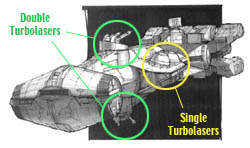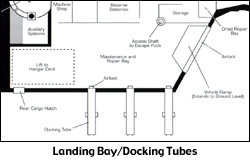

 |

|
|
ModificationsThe FarStar has had many modifications over its decades of service. The most recent refitting under the direction of Moff Sarne has resulted in significant changes to the ship. SensorsThe FarStar is now equipped with advanced sensors and tracking hardware that nearly doubles the original range of the sensor system. The sensor systems are more sensitive than those found aboard an Imperial Star Destroyer. This refitting gives the FarStar an important advantage: it can often detect and learn about a ship before the opposing vessel has detected the Corvette. Unfortunately, the new system takes up more room than the original sensor system and also draws significantly more power, in part accounting for the power conservation policies aboard the ship. Weapons
The FarStar's turbolasers have new "predict and pinpoint" targeting routines, but the gunners, who are used to standard targeting systems, are having trouble adjusting to the new system. The technicians insist that the targeting subroutines can only help their gunnery and if the operators give the system a chance to "settle in", their hit-to-miss ratio will improve drastically. The gunners simply want the Corvette's standard targeting programs reinstalled. When all is said and done, the programming and the egos of the weapons teams effectively cancel each other out, making for a fairly typical combination of gunner and machine. The targeting system provides some assistance for standard "point and shoot" volleys (+2 to Gunnery skill), but if the targeting computers can track a target for a full 5 seconds, the tracking system's computer assistance increases to +6 to Gunnery skill, giving the gunners a decided advantage against standard targeting systems. The trick is to keep the target in your sights for the full 5 seconds. To get this bonus, the gunner can do nothing but target for five rounds, making a single unmodified Gunnery skill roll to keep the target in sight. ArmorA major change is the upgrading of the FarStar's hull and armor plating. The FarStar is now significantlly tougher than a standard Corellian Corvette. This added armor plating has increased the thickness of the hull (nearly a full two meters is allocated for hull plating, maintenance crawlways, power conduits and reinforced bulkheads), but this armor plating also means the FarStar has a significantly higher chance of surviving an attack. Landing Bay/Docking Tubes
Moff Sarne decided to add a large landing bay and three docking tubes to accomodate shuttles and TIE Interceptors. Sarned, knowing the ship would be entering a hostile sector of space, knew that additional support craft would be necessary for the ship to survive its mission. When the New Republic captured the ship, the landing bay was not quite finished. While the flight deck, the main airlock and the magnetic field generators had been installed (making the landing bay operational), the Imperial engineers had not yet had the chance to install the TIE fighter racks. The New Republic found it could fit four X-wing fighters internally, five if an X-wing was placed on the lift that goes down to the maintenance level. Up to four New Republic Defender fighters can be crammed in-between the X-wings, but virtually no room is left for maneuvers and a rapid launch of fighter support is impossible. The main airlock is large enough to dock most capital ships or to accomodate a light freighter -- the FarStar's crew uses the airlock to load ground vehicles and large cargoes onto the Aegis combat shuttle. The three docking tubes, which connect at the maintenance level (one level below the main flight deck), can dock three ships each. Normally X-wing or Defender fighters are docked on the side airlocks while freighters and shuttles are docked on the ends of the docking tubes. The end airlocks can also be used for a ship-to-ship docking link. Normally, the basic hull structure of the Corellian Corvette does not support a docking bay configuration, but by adjusting the hyperspace signature of the engines, the engineers were able to accommodate the bay and docking tubes. CommunicationsThe FarStar has a high-power subspace transceiver courtesy of Moff Sarne's refitting operation. While the Moff couldn't spare a hyperradio transceiver (these communication systems are extremely expensive and not in common usage except for Imperial and New Republic military command vessels), the subspace transceiver is boosted for a broacast range of nearly 100 light years, or roughly four times the distance of many subspace transceivers. This unit can broatcast signals to any transceiver within range, although most transceivers are limited to a standard broadcast range of 25 light years, so not too many units will be able to broadcast response messages and have them reach the FarStar. Moff Sarne intended the Renegade to use this unit to provide regular updates regarding its exploration mission without uplinking into the civilian and military subspace communications nets. This would guarantee a secured communications link. Of course, Moff Sarne had a similarly powerful subspace transceiver on Kal'Shebbol, although it was destroyed during the New Republic's assault. The FarStar's communications crew is trying to reconfigure the subspace transceiver. It is a virtual certainty that Sarne's forces are monitoring the pre-programmed subspace channels. The crews are attempting to jury-rig a link on a (hopefully) unmonitored channel so that broadcasts may be sent to the New Republic provisional government on Kal'Shebbol. The communications crew is also working on developing new encryption techniques to foil the Empire's techs. Finally, the FarStar's communication teams intend to use the subspace transceiver to tap into Moff Sarne's network. Though most of Sarne's original codes have been changed and upgraded, there might still be a few which will allow the FarStar to eavesdrop. |
 |
||